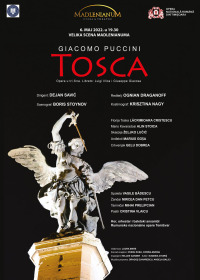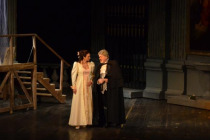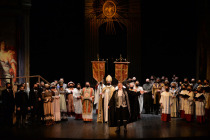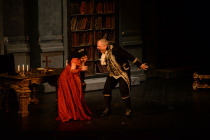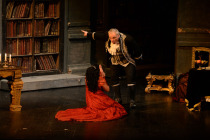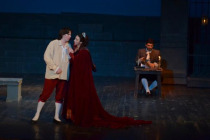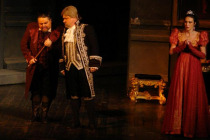Giacomo Puccini
TOSCA
Book & Buy TicketsMINISTRY OF CULTURE NATIONAL ROMANIAN OPERA HOUSE, from TIMIȘOARA
46th EDITION, „TIMIȘOARA MUZICALĂ” INTERNATIONAL FESTIVAL, 4th -27th MAY
Friday, 6th May 2022, at 1900
Performance sustained at the „Madlenianum” Theater from Belgrad
TOSCA
Opera in three acts. Music: Giacomo Puccini
Libretto: Luigi Illica and Giuseppe Giacosa
Conductor: DEJAN SAVIČ
Production: OGNIAN DRAGANOFF
Set designer: BORIS STOYNOV
Costume designer: KRISZTINA NAGY
Concert maestros: OVIDIU RUSU, CORINA MURGU
Chorus Maestro: LAURA MARE
Cast:
Floria Tosca LĂCRIMIOARA CRISTESCU
Mario Cavaradossi ALIN STOICA
Scarpia ZELJKO LUČIĆ
Angelotti MARIUS GOȘA
A sacristan GELU DOBREA
Spoletta VASILE BĂDESCU
Sciaronne MIRCEA DAN PETCU
A Jailer MIHAI PRELIPCIAN
A Shepherd boy CRISTINA VLAICU
The choir and orchestra of the National Romanian Opera House from Timisoara.
Stage director: HELLEN GANSER
Musical preparation: DRAGOȘ ZAHARESCU, ANGELA BALICI, RAREȘ PĂLTINEANU
Souffleur: EUGENIA GYURIS
Performance sung in Italian language
Estimated run time: 2h, 20 min. (2 pauses)
Recommended age: 10+
The National Opera House from Timisoara, Romania is a cultural public institution subordinated to the Ministry of Culture, his activity being held on annual artistic seasons, performing opera, operetta, ballet and opera for children performances, at home as well abroad.
The National Opera House from Timisoara was establishing through Royal Decree no. 254/31st of March, 1946. The very first manager was Aca de Barbu.
Timisoara was and it is in the present as well, the most dynamic cultural centre from the western part of Romania, the favourite geographical settlement, at the confluence of Central and East of Europa, offers a large opening on cultural aspects. Situated at 700 km away from the 13 Europeans capitals, Timisoara had over time a continuous connection to the values of the continent cultures. Also, the population of this area multi-ethnic and multicultural, belonging to various ethnicities and religions, make from Timisoara a model of European civilization.
Since the end of the 18th century, in Timisoara were played frequently opera seasons with a varied repertoire, with nothing lower than in major European cities, many of which presented here immediately after their absolute premieres.
The construction of the Opera began in 1871, after the plans of the Viennese architects Hermann Helmer and Ferdinand Fellner (builders of many theatres in Europe), was completed in 1875. Two major fires have ravaged the building, first in 1888 and the second in 1920, remaining intact only the marginal wings of the building. Reconstruction from the 1928 was made under the plans of Duiliu Marcu on a different architectural style: Romanian New-Byzantine.
In this building, four cultural institution have their headquarter and sustain annual seasons, in this very unique way: besides the National Opera House, the National Theatre "Mihai Eminescu", German Theatre and the Hungarian Theatre "Csiky Gergely", in three different languages.
After 1945, when the Opera House from Cluj-Napoca exiled at Timisoara due to the Vienna Dictate, could return to the native city, Timisoara was unimaginable without an opera house. So, at 30th of March, 1946 the institution was establish and in 27th of April, 1947, the first performance was presented: Giuseppe Verdi’s ’’Aida’’. It was noted as an unforgettable high artistic performance, a triumph of Romanian performing arts. After years, on the initiative of the great musicians, conductors Nicolae Boboc and Ion Românu, in the 1968-1969 season, take place, the first edition of the Festival "Timișoara Muzicală", thought to be an event of the year, a manifestation of excellent act of culture. After the sixth edition, the festival gets annually, and in 1993 will receive an international character, preserved until today.
The second festival held in Timisoara by the National Opera House is the Festival of Opera and Operetta (in open air), extremely popular event, that takes place annually at the end of August, split in two weekends, offering free to the public, the most beautiful performances from the repertoire of the institution.
The artistic tours, undertaken in the country and abroad met both public appreciation and the critics in most European countries (Austria, Belgium, Bulgaria, Switzerland, France, Germany, Greece, Italy, Luxembourg, Netherlands, Portugal, Spain), as well in countries like: India and Qatar.
On 24th of September, 2004, the Opera House from Timisoara received the title of National Opera House, as recognition of his special merits, for all hard work in the service of Romanian art and culture in the country and abroad.
Another major event recorded in the history of this institution it belongs to the politics. The Romanian Revolution of December 1989, started at Timisoara, began and developed in the building of the Opera House; the balcony of this building became the Romanian Revolution Balcony, as a symbol of people freedom, the image of this balcony rounded the world.
Synopsis:
ACT I
Rome, June 1800. Cesare Angelotti, an escaped political prisoner, rushes into the Church of Sant’Andrea della Valle. After finding the key his sister has hidden for him, he hides in his family’s private chapel. Soon, the painter Mario Cavaradossi arrives to work on his portrait of Mary Magdalene. The painting has been inspired by Angelotti’s sister, the Marchesa Attavanti, whom Cavaradossi had seen praying in the church. Angelotti, who was a member of the former Bonapartiste government, emerges from his hiding place. Cavaradossi recognizes him and promises help, then hurries him back into the chapel as the singer Floria Tosca, his lover, calls from outside. When he lets her into the church, she jealously asks Cavaradossi to whom he has been talking and reminds him of their rendezvous that evening. Suddenly recognizing the Marchesa Attavanti in the painting, she accuses him of being unfaithful, but he assures her of his love. When Tosca has left, Angelotti again comes out of hiding. A cannon signals that the police have discovered the escape, and he and Cavaradossi flee to the painter’s home. The sacristan enters with choirboys who are preparing to sing in a Te Deum celebrating the recent victory against Napoleon at the Battle of Marengo. At the height of their excitement, Baron Scarpia, chief of the secret police, arrives, searching for Angelotti. When Tosca comes back looking for Cavaradossi, Scarpia shows her a fan with the Attavanti crest that he has just found. Seemingly confirming her suspicions about her lover’s infidelity, Tosca is devastated. She vows vengeance and leaves as the church fills with worshippers. Scarpia sends his men to follow her to Cavaradossi, with whom he thinks Angelotti is hiding. While the congregation intones the Te Deum, Scarpia declares that he will bend Tosca to his will.
ACT II
That evening in his chambers in the Palazzo Farnese, Scarpia anticipates the pleasure of having Tosca in his power. The spy Spoletta arrives with news that he was unable to find Angelotti. Instead, he brings in Cavaradossi. Scarpia interrogates the defiant painter while Tosca sings at a royal gala in the palace courtyard. Scarpia sends for her, and she appears just as Cavaradossi is being taken away to be tortured. Frightened by Scarpia’s questions and Cavaradossi’s screams, Tosca reveals Angelotti’s hiding place. Henchmen bring in Cavaradossi, who is badly hurt and hardly conscious. When he realizes what has happened, he angrily confronts Tosca, just as the officer Sciarrone rushes in to announce that Napoleon actually has won the battle, a defeat for Scarpia’s side. Cavaradossi shouts out his defiance of tyranny, and Scarpia orders him to be executed. Once alone with Tosca, Scarpia calmly suggests that he would let Cavaradossi go free if she’d give herself to him. Fighting off his advances, she declares that she has dedicated her life to art and love and calls on God for help. Scarpia becomes more insistent, but Spoletta bursts in: Faced with capture, Angelotti has killed himself. Tosca, now forced to give in or lose her lover, agrees to Scarpia’s proposition. Scarpia orders Spoletta to prepare for a mock execution of Cavaradossi, after which he is to be freed. Tosca demands that Scarpia write her a passage of safe-conduct. After he has done so, he attempts to make love to Tosca, but she grabs a knife from the table and stabs him. She takes the pass and flees.
ACT III
At dawn, Cavaradossi awaits execution on the ramparts of Castel Sant’Angelo. He bribes the jailer to deliver a farewell letter to Tosca, and then, overcome with emotion, gives in to his despair. Tosca appears and explains what has happened. The two imagine their future in freedom. As the execution squad arrives, Tosca implores Cavaradossi to fake his death convincingly, then watches from a distance. The soldiers fire and depart. When Cavaradossi doesn’t move, Tosca realizes that the execution was real, and Scarpia has betrayed her. Scarpia’s men rush in to arrest her, but she cries out that she will meet Scarpia before God and leaps from the battlement.

